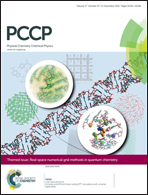Confined helium on Lagrange meshes
Abstract
The Lagrange-mesh method has the simplicity of a calculation on a mesh and can have the accuracy of a variational method. It is applied to the study of a confined helium atom. Two types of confinement are considered. Soft confinements by potentials are studied in perimetric coordinates. Hard confinement in impenetrable spherical cavities is studied in a system of rescaled perimetric coordinates varying in [0,1] intervals. Energies and mean values of the distances between electrons and between an electron and the helium nucleus are calculated. A high accuracy of 11 to 15 significant figures is obtained with small computing times. Pressures acting on the confined atom are also computed. For sphere radii smaller than 1, their relative accuracies are better than 10−10. For larger radii up to 10, they progressively decrease to 10−3, still improving the best literature results.

- This article is part of the themed collection: Real-space numerical grid methods in quantum chemistry

 Please wait while we load your content...
Please wait while we load your content...